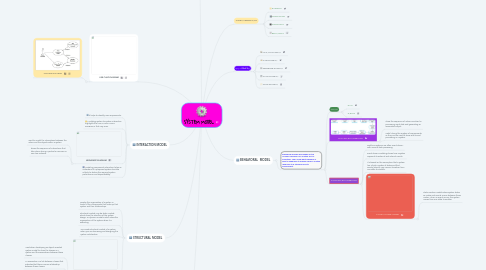
1. CONTEXT MODEL
1.1. To illustrate the operational context of a system - they show what lies outside the system boundaries.
1.2. Architectural models show the system and its relationship with other systems.
1.3. SYSTEM BOUNDARIES
1.3.1. To define what is inside and what is outside the system.
1.3.2. The position of the system boundary has a profound effect on the system requirements.
1.3.3. Defining a system boundary is a political judgment
1.4. PROCESS MODEL
1.4.1. ACTIVITY DIAGRAM
2. INTERACTION MODEL
2.1. it helps to identify user requirements.
2.2. Modeling system-to-system interaction highlights the COMMUNICATION PROBLEMS that may arise.
2.3. SEQUENCE DIAGRAM
2.3.1. used to model the interactions between the actors and the objects within a system.
2.3.2. shows the sequence of interactions that take place during a particular use case or use case instance.
2.4. Modeling component interaction helps us understand if a proposed system structure is likely to deliver the required system performance and dependability.
3. STRUCTURAL MODEL
3.1. Display the organization of a system in terms of the components that make up that system and their relationships.
3.2. Structural models may be static models, which show the structure of the system design, or dynamic models, which show the organization of the system when it is executing.
3.3. You create structural models of a system when you are discussing and designing the system architecture.
3.4. CLASS DIAGRAM
3.4.1. used when developing an object-oriented system model to show the classes in a system and the associations between these classes.
3.4.2. An association is a link between classes that indicates that there is some relationship between these classes.
4. USE CASE DIAGRAM
4.1. INCLUDE & EXTEND
5. CONCLUSION
5.1. A model is an abstract view of a system that ignores system details. Complementary system models can be developed to show the system’s context, interactions, structure and behavior.
5.2. Context models show how a system that is being modeled is positioned in an environment with other systems and processes
5.3. Use case diagrams and sequence diagrams are used to describe the interactions between users and systems in the system being designed. Use cases describe interactions between a system and external actors; sequence diagrams add more information to these by showing interactions between system objects.
5.4. Structural models show the organization and architecture of a system. Class diagrams are used to define the static structure of classes in a system and their associations.
5.5. Behavioral models are used to describe the dynamic behavior of an executing system. This behavior can be modeled from the perspective of the data processed by the system, or by the events that stimulate responses from a system.
5.6. Activity diagrams may be used to model the processing of data, where each activity represents one process step.
5.7. State diagrams are used to model a system’s behavior in response to internal or external events.
6. SYSTEM PERSPECTIVES
6.1. EXTERNAL
6.2. INTERACTION
6.3. STRUCTURAL
6.4. BEHAVIORAL
7. UML DIAGRAM
7.1. ACTIVITY DIAGRAM
7.2. CASE DIAGRAM
7.3. SEQUENCE DIAGRAM
7.4. CLASS DIAGRAM
7.5. STATE DIAGRAM
8. BEHAVIORAL MODEL
8.1. Behavioral models are models of the dynamic behavior of a system as it is executing. They show what happens or what is supposed to happen when a system responds to a stimulus from its environment.
8.1.1. STIMULI
8.1.1.1. DATA
8.1.1.2. EVENTS
8.1.2. DATA-DRIVEN MODELLING
8.1.2.1. Show the sequence of actions involved in processing input data and generating an associated output.
8.1.2.2. useful during the analysis of requirements as they can be used to show end-to-end processing in a system.
8.1.3. EVENT-DRIVEN MODELLING
8.1.3.1. Real-time systems are often event-driven, with minimal data processing.
8.1.3.2. Event-driven modeling shows how a system responds to external and internal events.
8.1.3.3. It is based on the assumption that a system has a finite number of states and that events (stimuli) may cause a transition from one state to another.
8.1.3.4. STATE MACHINE MODEL
8.1.3.4.1. State machine models show system states as nodes and events as arcs between these nodes. When an event occurs, the system moves from one state to another.

